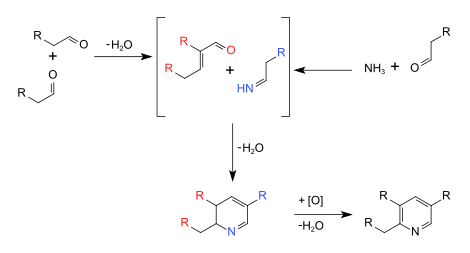
A | B | C | D | E | F | G | H | CH | I | J | K | L | M | N | O | P | Q | R | S | T | U | V | W | X | Y | Z | 0 | 1 | 2 | 3 | 4 | 5 | 6 | 7 | 8 | 9
| Chichibabin pyridine synthesis | |
|---|---|
| Named after | Aleksei Chichibabin |
| Reaction type | Ring forming reaction |
| Identifiers | |
| RSC ontology ID | RXNO:0000526 |
The Chichibabin pyridine synthesis (/ˈtʃiːtʃiːˌbeɪbiːn/) is a method for synthesizing pyridine rings. The reaction involves the condensation reaction of aldehydes, ketones, α,β-Unsaturated carbonyl compounds, or any combination of the above, with ammonia.[1] It was reported by Aleksei Chichibabin in 1924.[2][3] Methyl-substituted pyridines, which show widespread uses among multiple fields of applied chemistry, are prepared by this methodology.[4]
Representative syntheses
The syntheses are presently conduced commercially in the presence of oxide catalysts such as modified alumina (Al2O3) or silica (SiO2). The reactants are passed over the catalyst at 350-500 °C. 2-Methylpyridine- and 4-methylpyridine are produced as a mixture from acetaldehyde and ammonia. 3-Methylpyridine and pyridine are produced from acrolein and ammonia. Acrolein and propionaldehyde react with ammonia affords mainly 3-methylpyridine. 5-Ethyl-2-methylpyridine is produced from paraldehyde and ammonia.[5]
Mechanism and optimizations
These syntheses involve many reactions such as imine synthesis, base-catalyzed aldol condensations, and Michael reactions.
Many efforts have been made to improve the method.[6][1] Conducting the reaction in the gas phase in the presence of aluminium(III) oxide.[4] zeolite (yield 98.9% at 500 K),[7]
From nitriles
Of the many variations have been explored. one approach employs nitriles as the nitrogen source. For example, acrylonitrile and acetone affords 2-methylpyridine uncontaminated with the 4-methyl derivative. In another variation, alkynes and nitriles react in the presence of organocobalt catalysts, a reaction inspired by alkyne trimerization.[5]
See also
- Chichibabin reaction
- Gattermann–Skita synthesis
- Hantzsch pyridine synthesis
- Ciamician–Dennstedt rearrangement
References
- ^ a b Frank, R. L.; Seven, R. P. (1949). "Pyridines. IV. A Study of the Chichibabin Synthesis". Journal of the American Chemical Society. 71 (8): 2629–35. doi:10.1021/ja01176a008.
- ^ Tschitschibabin, A. E. (1924). "Über Kondensation der Aldehyde mit Ammoniak zu Pyridinbasen". Journal für Praktische Chemie. 107 (1–4): 122–8. doi:10.1002/prac.19241070110.
- ^ Li, J. J. (2009). "Chichibabin pyridine synthesis". Name Reactions. pp. 107–9. doi:10.1007/978-3-642-01053-8_51. ISBN 978-3-540-40203-9.
- ^ a b Sagitullin, R. S.; Shkil, G. P.; Nosonova, I. I.; Ferber, A. A. (1996). "Synthesis of pyridine bases by the Chichibabin method (review)". Chemistry of Heterocyclic Compounds. 32 (2): 127–40. doi:10.1007/BF01165434. S2CID 93717043.
- ^ a b Shimizu, S.; Watanabe, N.; Kataoka, T.; Shoji, T.; Abe, N.; Morishita, S.; Ichimura, H. "Pyridine and Pyridine Derivatives". Ullmann's Encyclopedia of Industrial Chemistry. Weinheim: Wiley-VCH. doi:10.1002/14356007.a22_399. ISBN 978-3527306732.
- ^ Weiss, M. (1952). "Acetic Acid—Ammonium Acetate Reactions. An Improved Chichibabin Pyridine Synthesis". Journal of the American Chemical Society. 74 (1): 200–2. doi:10.1021/ja01121a051.
- ^ Krishna Mohan, K. V. V.; Reddy, K. S. K.; Narender, N.; Kulkarni, S. J. (2008). "Zeolite Catalysed Synthesis of 5-Ethyl-2-methylpyridine under High Pressure". Journal of Molecular Catalysis A: Chemical. 298 (1–2): 99–102. doi:10.1016/j.molcata.2008.10.010.
Text je dostupný za podmienok Creative Commons Attribution/Share-Alike License 3.0 Unported; prípadne za ďalších podmienok. Podrobnejšie informácie nájdete na stránke Podmienky použitia.
Antropológia
Aplikované vedy
Bibliometria
Dejiny vedy
Encyklopédie
Filozofia vedy
Forenzné vedy
Humanitné vedy
Knižničná veda
Kryogenika
Kryptológia
Kulturológia
Literárna veda
Medzidisciplinárne oblasti
Metódy kvantitatívnej analýzy
Metavedy
Metodika
Text je dostupný za podmienok Creative
Commons Attribution/Share-Alike License 3.0 Unported; prípadne za ďalších
podmienok.
Podrobnejšie informácie nájdete na stránke Podmienky
použitia.
www.astronomia.sk | www.biologia.sk | www.botanika.sk | www.dejiny.sk | www.economy.sk | www.elektrotechnika.sk | www.estetika.sk | www.farmakologia.sk | www.filozofia.sk | Fyzika | www.futurologia.sk | www.genetika.sk | www.chemia.sk | www.lingvistika.sk | www.politologia.sk | www.psychologia.sk | www.sexuologia.sk | www.sociologia.sk | www.veda.sk I www.zoologia.sk


